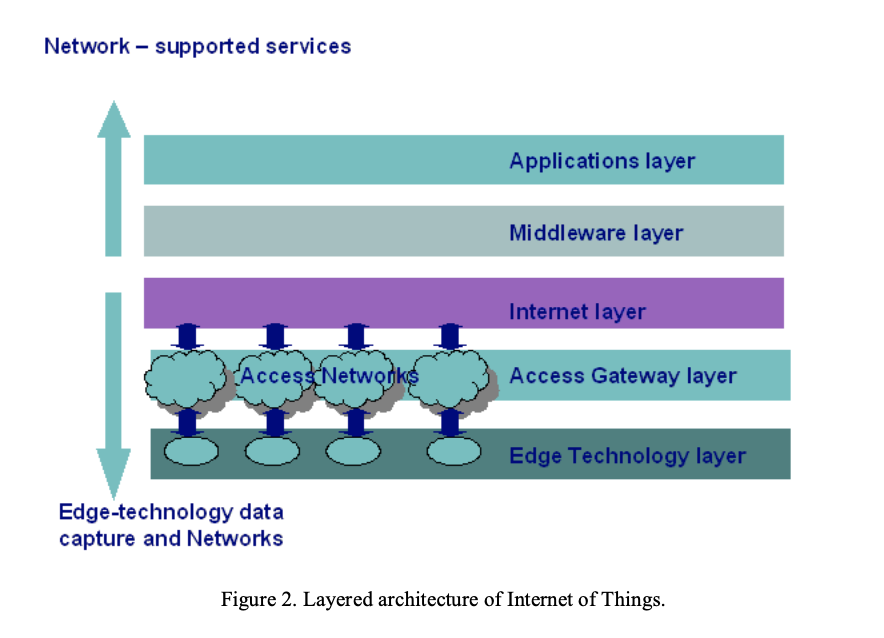The term “Internet of Things” (IoT) was first used in 1999 by British technology pioneer Kevin Ashton to describe a system in which objects in the physical world could be connected to the Internet by sensors Ashton coined the term to illustrate the power of connecting Radio-Frequency Identification (RFID) tags used in corporate supply chains to the Internet in order to count and track goods without the need for human intervention.
Today, the Internet of Things has become a popular term for describing scenarios in which Internet connectivity and computing capability extend to a variety of objects, devices, sensors, and everyday items. Figure 1 shows visions of IoT and Figure 2 shows the architecture of IoT.


The middleware (a software layer interposed between the technological and application levels) architectures proposed in the last couple of years for IoT often follow the service oriented architecture (SOA) approach. The adoption of the SOA principles allows for decomposing complex and monolithic systems into applications consisting of an ecosystem of simpler and well-defined components. The use of common interfaces and standard protocols gives a horizontal view of an enterprise system. Therefore, the development of the business process of designing workflows of coordinated services, which eventually are associated with objects actions. An SOA approach also allows for software and hardware reuse, because it does not impose a specific technology for service implementation. Figure 3 presents a generic SOA-based architecture for the IoT middle-ware.

While the term “Internet of Things” is relatively new, the concept of combining computers and networks to monitor and control devices has been around for decades. By the late 1970s, for example, systems for remotely monitoring meters on the electrical grid via telephone lines were already in commercial use. In the1990s, advances in wireless technology allowed “machine to machine” (M2M) enterprise and industrial solutions for equipment monitoring and operation to become widespread. Many of these early M2M solutions, however, were based on closed purpose built networks and proprietary or industry specific standards rather than on Internet Protocol (IP)based networks and Internet standards.
Using IP to connect devices other than computers to the Internet is not a new idea. The first Internet “device”an IPenabled toaster that could be turned on and off over the Internet was featured at an Internet conference in 1990. Over the next several years, other “things” were IPenabled, including a soda machine at Carnegie Mellon University in the US and a coffee pot in the Trojan Room at the University ofCambridge in the UK (which remained Internet–connected until 2001). From these whimsical beginnings, robust field of research and development into “smart object networking” helped create the foundation for today’s Internet of Things.
From a broad perspective, the confluence of several technology and market trends is making it possible to interconnect more and smaller devices cheaply and easily:
- Ubiquitous Connectivity: Low Cost, highspeed, pervasive network connectivity, especially through licensed and unlicensed wireless services and technology, makes almost everything “connectable’’.
- Widespread adoption of IP–based networking: IP has become the dominant global standard for networking, providing a well–defined and widely implemented platform of software and tools that can be incorporated into a broad range of devices easily and inexpensively.
- Computing Economics: Driven by industry investment in research, development, and manufacturing, Moore’s law continues to deliver greater computing power at lower price points and lower power consumption
- Miniaturisation: Manufacturing advances allow cutting-edge computing and communications technology to be incorporated into very small objects. Coupled with greater computing economics,this has fueled the advancement of small and inexpensive sensor devices, which drive many IoTapplications.
- Advances in Data Analytics: New algorithms and rapid increases in computing power, data storage,and cloud services enable the aggregation, correlation, and analysis of vast quantities of data; these large and dynamic datasets provide new opportunities for extracting information and knowledge.
- Rise of Cloud Computing: Cloud computing, which leverages remote, networked computing resources to process, manage, and store data, allows small and distributed devices to interact with powerful back-end analytic and control capabilities.
From this perspective, the IoT represents the convergence of a variety of computing and connectivity trends that have been evolving for many decades. At present, a wide range of industry sectors including automotive, healthcare, manufacturing, home and consumer electronics, and well beyond are considering the potential for incorporating IoT technology into their products, services, and operations.
In this paper, the authors would like to present an overview about the Internet of Things (IoT) with aspects: Communication Models, Technologies, Application and Open Issues. For each topic, authors will discuss in each section. The authors hope that this paper will give an overview related issues in IoT.
Thanh-Phuoc Nguyen , Giao N. Pham , Binh A. Nguyen , Ngoc T. Le , and Trong-Hai Nguyen